-
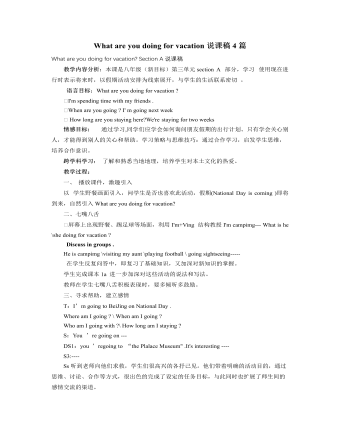
人教版新目标初中英语八年级上册What are you doing for vacation说课稿4篇
这一环节我采用电影《哈利波特》中哈利去霍格华兹的图片引入“how does Harry go to school?” 进而引入” how do you go to school?” 呈现“the ways to go to school” 让学生明确take 的使用及与交通工具的搭配。接着让学生根据实际情况回答自己采用的交通方式,期间可以引入“how does he /she go to school?” 基本了解了怎么说后进入课文,完成1a 部分练习 和1 b 的听力练习。完成后让学生玩一个数字游戏,帮学生回忆数字。通过问学生从家里出发时间和到达时间,引出“it takes ?? minutes .” 的句型。借助ppt 图片进行句型操练。然后完成听力练习2a—2c。本环节用时20分钟。While-task:本堂课的主要任务是让学生运用已学的语言知识,完成一个任务,即计算从学校到上海各种交通工具所需要的时间和费用,讨论应选用和种交通工具和各种优缺点。这一环节将用时10分钟。
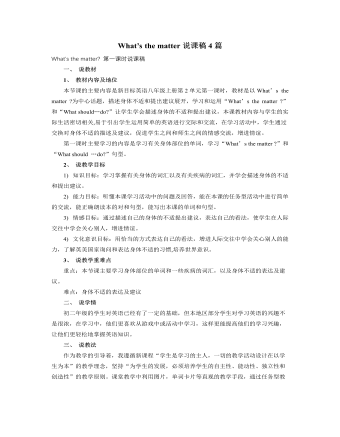
人教版新目标初中英语八年级上册What’s the matter说课稿4篇
在任务环活动中,我通过设计不同的四个任务,让学生在小组中交流、合作、竞争,每个任务都存在着一定的“信息差”,易于激发学生的表达欲望和急于知道最终结果的心情,在活动中他们一定会努力表现自己,做到最好。四个任务所侧重的训练学生的语言能力的要求也各有不同,他们分别侧重训练学生的听、说、读、写的能力。把任务活动放在小组中进行,还可以解决“大班”难于操练的难题,学生在小组中有更多的时间来运用英语表达自己的思想。Post-task任务后活动(4”)1. Grammar Focus(2”)Go through the Grammar Focus with the whole class,ask Ss to point out the main points in this period. Then show the use of The Past Tense on the screen, especially the regular and irregular changes of verbs. 2. Language practice(2”)Practise the sentence patterns and the use of the Past Tense, especially the errors which Ss made while carrying out their tasks. Such as Subject-verb agreement or Tense-agreement, etc. For example: were you see any sharks? He go to the beach. 在学生尽情地参与活动后再让学生反思本节课的语法焦点,并进行适当的操练,对学生在任务活动中的语言失误进行纠正,使学生保持学习信心。语法讲解采用动画形式又保持了学生的学习兴趣。
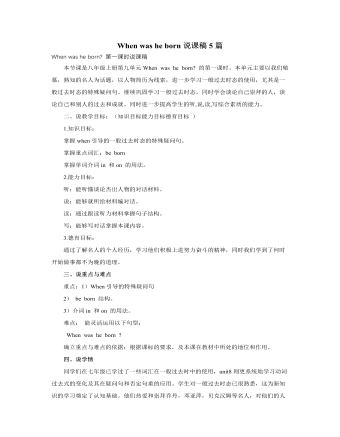
人教版新目标初中英语八年级上册When was he born说课稿5篇
1. 教学重点(1)新单词及目标语言的掌握。(2)听、说、读、写的综合训练。(3)对对合作及小组合作练习口语的训练。2. 教学难点(1)when所引导的特殊疑问句。(2)询问生日与出生年月日的区别。When is your birthday? (一般现在时)When were you born?(一般过去时) (3)表达年月日时所用的不同介词:in+年/月;on+日期二、教学方法。由浅入深,由易到难,由已知到未知,从学生熟悉的运动明星、电影明星甚至是歌手入手,调动他们的学习积极性,让他们在心情愉快、兴趣浓厚的氛围中展开一系列听说读写的训练,主动地投入到学习中去,自然地掌握本单元的重点、难点;循序渐进地深化教学内容,同时以训练学生听说为主,展开以老师为主导,以学生为主体的师生双边互动活动。三、教学手段。利用名人图片来辅助新的语言知识的巩固和训练;采用多媒体教学,并把听力内容录到电脑中,锻炼了学生的视听能力,提高了教学效果。
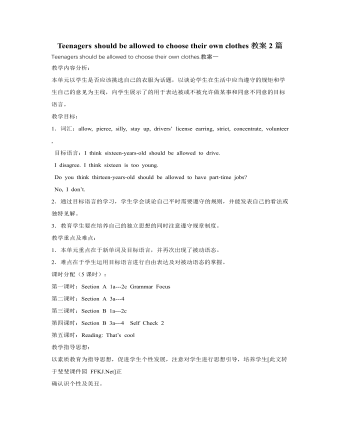
人教版新目标初中英语九年级上册Teenagers should be allowed to choose their own clothes教案2篇
Step 1 Greeting Greet the class and check the homeworkStep 2 A duty report The S on duty gives a report on the rules in his home and lead in 3a “Sun Fei’s and Wu Yu’s rules” Step 3 ReadingSs read the conversation and write the two girls’ rules in the chart. Check the answers.Get Ss to read after the tape and then read aloud by themselves. Then, T explains the language points.Step 4 Pairwork 3bRole play. Use the information in chart to practice with the conversation in 3a covered. They can look at the sample conversation in the right box.Step 5 Task 2 “Who’s the best reporter?”Make a survey by asking any 5 students the questions in the chart in activity 4. Then give out a report about it. See who is the best reporter? And the best reporter will get a nice ball-pen.Step 6 Summary and homework:Write out the report in your exercise-books.Period ThreeStep 1 Greeting and a duty reportThe S gives a duty report talking about his experience of being late for school. Lead in the question “Do you ever get to school late? How often do you get to school late? Always, usually, sometimes, or never?Step 2 1a Get Ss to finish writing.Step 3 Pairwork 1b Get Ss to talk about their answers with their partners using the sample conversation in the box on the right.Step 4 Listening practice2a Lead-in: What will happen if you get to school late? What about Peter? Let’s listen to a conversation between Peter and his father. Get Ss to finish 2a (As usual, for the first time, Ss only listen.) Check the answers.
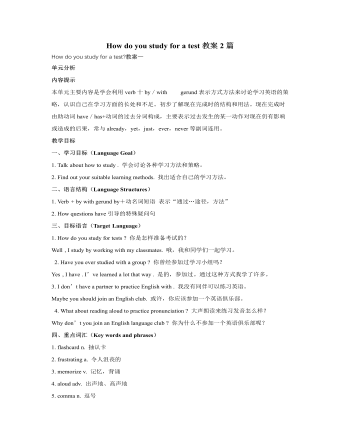
人教版新目标初中英语九年级上册How do you study for a test教案2篇
内容提示本单元主要内容是学会利用verb十by/with gerund表示方式方法来讨论学习英语的策略,认识自己在学习方面的长处和不足。初步了解现在完成时的结构和用法。现在完成时由助动词have/has+动词的过去分词构成,主要表示过去发生的某一动作对现在仍有影响或造成的后果,常与already,yet,just,ever,never等副词连用。教学目标一、学习目标(Language Goal) 1. Talk about how to study . 学会讨论各种学习方法和策略。2. Find out your suitable learning methods. 找出适合自己的学习方法。 二、语言结构(Language Structures) 1. Verb + by with gerund by+动名词短语 表示“通过…途径,方法” 2. How questions have引导的特殊疑问句 三、目标语言(Target Language) 1. How do you study for tests ? 你是怎样准备考试的?Well , I study by working with my classmates. 哦,我和同学们一起学习。2. Have you ever studied with a group ? 你曾经参加过学习小组吗?Yes , I have . I’ve learned a lot that way . 是的,参加过。通过这种方式我学了许多。
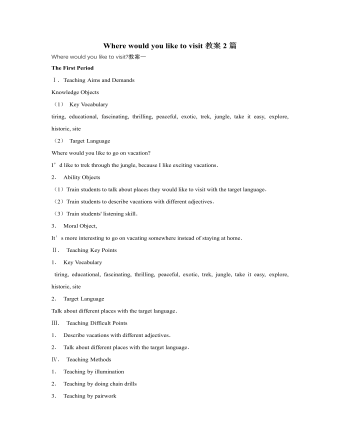
人教版新目标初中英语九年级上册Where would you like to visit教案2篇
The First PeriodⅠ.Teaching Aims and DemandsKnowledge Objects(1) Key Vocabularytiring, educational, fascinating, thrilling, peaceful, exotic, trek, jungle, take it easy, explore, historic, site(2) Target LanguageWhere would you like to go on vacation?I’d like to trek through the jungle, because I like exciting vacations.2. Ability Objects(1)Train students to talk about places they would like to visit with the target language.(2)Train students to describe vacations with different adjectives.(3)Train students' listening skill.3. Moral Object,It′s more interesting to go on vacating somewhere instead of staying at home.Ⅱ. Teaching Key Points1. Key Vocabularytiring, educational, fascinating, thrilling, peaceful, exotic, trek, jungle, take it easy, explore, historic, site2. Target LanguageTalk about different places with the target language.Ⅲ. Teaching Difficult Points1. Describe vacations with different adjectives.2. Talk about different places with the target language.Ⅳ. Teaching Methods1. Teaching by illumination2. Teaching by doing chain drills3. Teaching by pairworkⅤ. Teaching Aids1. A tape recorder2. Some pictures of different places with famous views
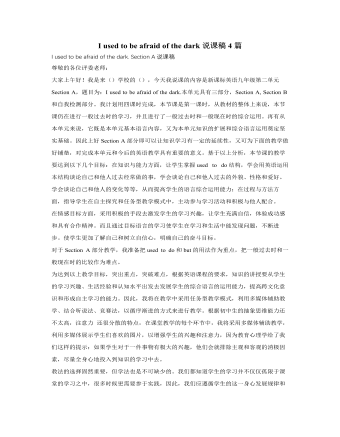
人教版新目标初中英语九年级上册I used to be afraid of the dark说课稿4篇
2、说说写写通过读写训练,进一步学会用 used to 结构来表达自己和同伴过去害怕,或现在仍旧害怕的事情,并且要把最后的结果书写下来,然后让他们将结果用英语告之其他同学,为学生创造展示才能的机会。这样能使全体同学都积极参与,集中精力认真听。既巩固了本节课的目标语言,又为下一个环节3b的对话打下基础。活动结问题比较容易,英语基础较差的学生也能够独立完成,因此,在检查答案是尽量让这部分学生回答,使他们体验到成功后的喜悦,提高他们学习英语的兴趣。 3.对话练习:让学生两人一组,模仿3a中的对话,根据提供的信息与提示词进行对话练习,目的在于对新学的目标语言进行口头练习与设定情景中的运用。为学生创造展示才能的机会。推荐两至三组的同学到教室前面,就所编的对话进行角色表演。
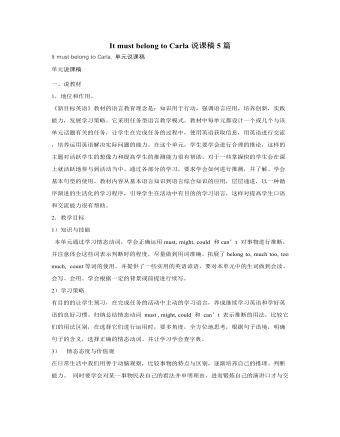
人教版新目标初中英语九年级上册It must belong to Carla说课稿5篇
二、教学目标: 1. 知识目标:要求学生掌握使用表示猜测的情态动词。2. 能力目标:让学生做课堂的主人,同时培养他们掌握一些行之有效的学习方法,优化学习效果。3. 情感目标:让学生爱上英语课堂活动,鼓励他们在课堂上进行合作交流。4.学习策略目标:设法使学生掌握使用英语进行交流,学习积极参与班级活动.三、教学分析:1. 说教法:1)任务型教学法:给学生三项任务, 让学生使用这些情态动词来完成这些任务。使他们在任务中学习英语。2)情景教学法:创造足够的交际环境刺激学生的视听能力,使他们能够更好的理解这些情态动词。以培养他们的听和会话能力。3)交易际教学法:学生可以通过俩俩对话或小组对话来掌握这些情态动词。2. 说学法:1)学生要善于把握机会,用英语进行沟通,大胆实践。
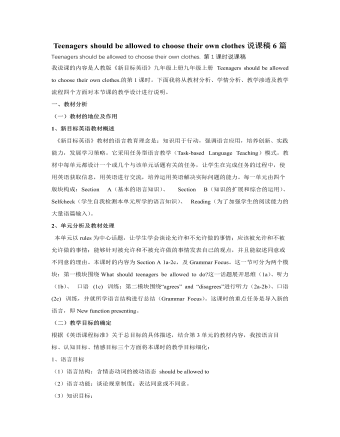
人教版新目标初中英语九年级上册Teenagers should be allowed to choose their own clothes说课稿6篇
二、教材分析本课时主要是以听和说的方式来谈论一些家庭和学校的“规矩和制度”,知道那些时可以做的,那些是不可以做的,让学生先从口头上了解这些规矩和制度,为后面的学习做好准备。三、教学的目的和要求1. 掌握短语be strict with sb.的用法,并介绍be strict in sth.的用法;2. 学生能够根据所学的知识,了解用什么方式/句型来制定规章制度。3. 多听,提高学生的习愿望,敦促学生开口说英语,用本课所学的知识来表达自己的意见。四、教学重点和难点1. 如何正确使用be allowed to do…这一句型(在不同时态中的被动语态运用)。2. 如何获得听力技巧及口语技能的提高。五、教学过程T—teacher S—studentS s—students Bb—blackboardStep 1 Warming up Check their homework first, and see if the Ss can make sentences by using the rules in 4, Section A. If possible, try to give some help.
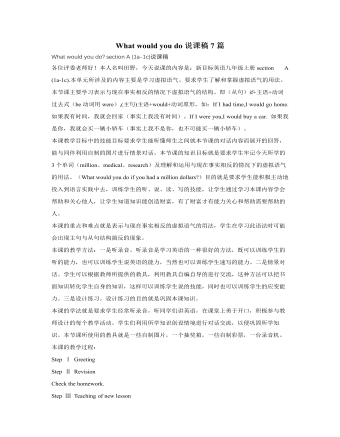
人教版新目标初中英语九年级上册What would you do说课稿7篇
Get students to complete the activity in groups of four. As the groups work together, move around the room to make sure students discuss the topic in English and know how to fill in the chart.Check the answers by asking different pairs of students to say their conversations to the class.Answers will vary.Optional activityAsk, What would you do if there were no classes tomorrow? Ask students to write as many answers as they can. Then get students to work in pairs. One ask the other the question and see how many new answers the other is able to think of.Step Ⅴ SummarySay, In this class, we've done a lot of reading, speaking and writing practice using the target language.Step Ⅵ Homework(1) Review the target language by reading the conversations in Activity 3a.(2) Finish off the exercises on pages 11~12 of the workbook.Step Ⅶ Blackboard DesignWhat would you do?Section AThe Third PeriodTarget language:A: I can't sleep the night before an exam. Then I'm too tired to do well. What should I do?B: If I were you, I'd take a long walk before going to bed. That should help you relax.A: I really want a dog, but my parents won't let me have one.B: Well, dogs can be a lot of trouble. Maybe you should get a small pet, like a goldfish.A: That's a good idea.
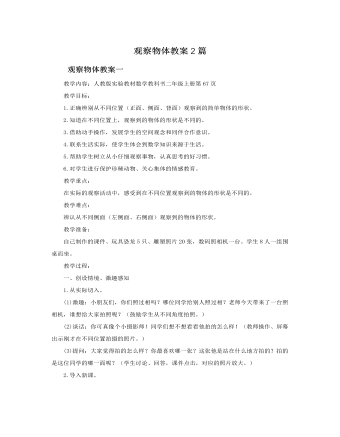
人教版新课标小学数学二年级上册观察物体教案2篇
教学过程:一、故事导入1.出示主题图配合音乐,师:“有一只蜻蜓在动物城里玩,遇到了辛勤工作的蜜蜂,看见了一座座漂亮的房屋。”蝴蝶说:“瞧。自己做了一件衣服,但是穿起来很不合身,怎么办?”(出现三种不对称的衣服图形)“于是,蝴蝶去找蜻蜓帮忙。”2.师:“一路上,蝴蝶看到许多美丽的景色,遇见许多动物朋友。瞧,美丽的孔雀走来了,还有知了、七星瓢虫、螃蟹。”3.师:“小朋友,它们美吗?你能说说你觉得它们哪儿美?(学生自由回答)那咱们把它们画下来,好吗?”二、初步感知对称图形的特点1.(指着蝴蝶形)师:“这么美的图形你想不想剪出一个来?请小朋友们拿出一张彩纸,用剪刀剪出这只蝴蝶,行吗?”(请学生说一说怎么剪的?)师:“有的小朋友剪出的蝴蝶为什么不像呢?为什么有的小朋友又能剪出美丽的蝴蝶呢?蝴蝶的形状到底有什么特点,让咱们来研究研究。”
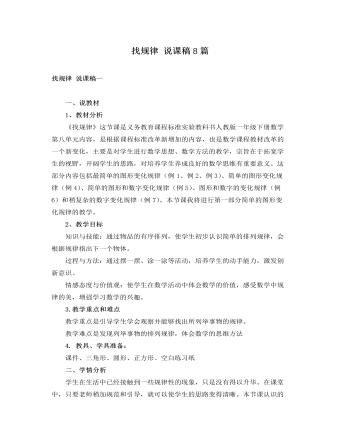
人教版新课标小学数学一年级下册找规律 说课稿8篇
刚才大家只用了几个简单的图形就摆出了这么多不同的的规律,可见数学真奇妙!认真观察这些作品,他们贴得都有规律吗?谁有问题想问大家?生可能问:看到这些规律,你有什么想说的吗?谁能看出黑板上摆的第一条规律?第三条继续摆,下一个是什么图形?最后一条该怎么分组,规律就看得特别清楚了?这些规律有什么相同和不同的地方?……师生共同总结出: 今天我们研究的规律都是有关图形的规律;摆放的图形的颜色、方向、形状以及个数的变化都可出现一些有趣的规律。聪明的设计师都习惯运用规律来布置我们周围的环境,我们也可以应用规律来美化我们的生活。六、反思拓展,总结全课师:这节课快上完了,评价一下自己吧.这节课你快乐吗?你会了吗?有没有遗憾?生活中有了规律就有了美,希望同学们课后继续去发现美,创造美,让我们的生活更加多姿多彩!
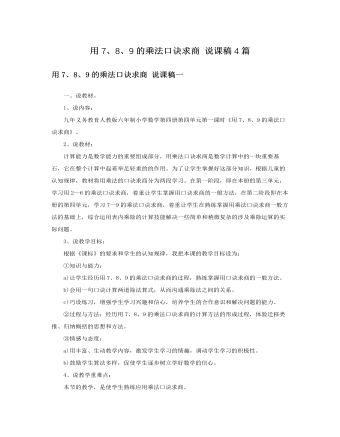
人教版新课标小学数学二年级下册用7、8、9的乘法口诀求商说课稿4篇
(二)解决问题,总结方法《新课程标准》主张充分挖掘数学教材潜在的“再创造空间”,让学生亲自经历将实际问题抽象成数学模型并进行解释与应用的过程,让学生最大限度地参与数学知识的发现、提出、形成、应用的再创造过程,以促进学生主动的发展。因此我创设了福娃晶晶为迎接奥运会做准备的数学情景,设计了四组有关7、8、9的用除法算式解决的数学问题。1、出示晶晶的问题:(1)做了56面彩旗,平均每行挂7面,能挂多少行?(2)做了56面彩旗,要挂成8行,平均每行挂多少面?(3)做了49颗五角星,平均分给7个小朋友,每人多少颗五角星?(4)准备了27个气球,平均9个摆一行,能摆多少行?2、解决晶晶的问题:让学生根据"友情提示"的要求完成自学内容后再小组交流、全班交流。在交流过程中引导学生观察:56÷8=7和56÷7=8这两个算式,从而发现一句乘法口诀可以计算两个除法算式。

《关心班级 热爱集体》主题班会教案
【活动主题】关心班级 热爱集体【活动目的】让班级同学都参与到活动中来,使同学们懂得关心集体,热爱班级的深刻含义。【活动准备】 1.让两位同学准备好关于“关心班级,热爱集体”的演讲稿。2.让同学们收集关于“关心班级,热爱集体”的名人名言。3.布置教室。【活动过程】一、教师导入学校是个大集体,班级是个小集体,为集体着想,就能汇成巨大的力量。一个人的成才,一个人的成功,都离不开集体。每一位同学都应该是关心班级,热爱集体的。为此,我们班这周专门组织了这次“关心班级,热爱集体”的主题班会。二、活动具体程序(一)活动开始:主持人1:尊敬的老师!主持人2:亲爱的同学们!合:大家好!主持人1:下面我宣布“关心班级,热爱集体”主题班会现在开始!(二)《关心集体热爱班级的重要意义》的演讲主持人1:下面请A同学为我们演讲“关心集体热爱班级的重要意义”
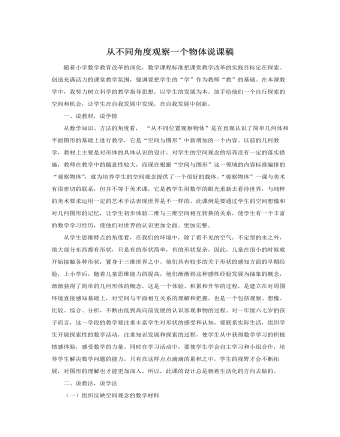
人教版新课标小学数学五年级上册从不同角度观察一个物体说课稿
(三)实践性数学是一种工具,一种将自然、社会运动现象法则化、简约化的工具。数学学习的最重要的成果就是学会建立数学模型,用以解决实际问题。因此,在这节课中,大量地创设条件,让学生把课堂中所学的知识和方法应用于生活实际之中,“学以致用”,让学生切实感受到生活中处处有数学。如上课伊始的猜冰箱,课中观察玩具、用品,给熊猫照相等,都采用了贴近学生生活的材料,旨在联系生活,开阔视野,同时延伸学习,使学生能从看到的物体的某一个面,联想到整个物体的形状,培养其观察立体实物的能力,建立初步的空间观念,发展形象思维。本课的所有教学环节都注重借助学生生活中常见的事物为知识载体,意在让学生感悟到“数学就在我们身边,生活离不开数学”。二、需进一步探究的问题“观察物体”的内容主要是对简单物体正面、侧面、上面形状的观察,因此本节课选择了大量生活中的实物让学生观察,旨在培养学生的空间观念。
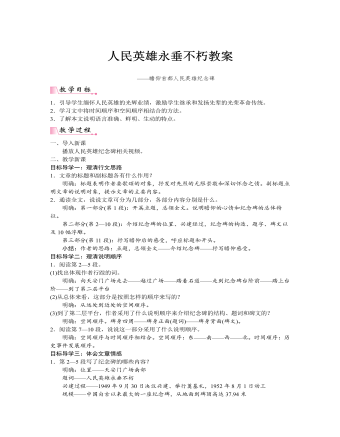
人教部编版语文八年级上册人民英雄永垂不朽教案
这篇文章的语言既有说明文语言准确、严密的特点,又有新闻特写鲜明、生动的特点,请和大家分享你最喜欢的语句,并说明理由。(学生发言)1.准确、严密示例:据地质学家化验证明,这些浮雕至少能耐800年到1000年之久。明确:“据地质学家化验证明”交代数据来源;“至少”对时间进行限定。2.鲜明、生动示例一:深夜,起义的新军和市民,摧毁了湖广总督府门前的大炮,正向总督府里冲去。总督府内熊熊的火焰冒向天空;总督府的牌子,被打断在阶前;撕碎了的清朝的龙旗,被践踏在地上。明确:“摧毁”“冲去”“冒”“打断”“撕碎”“践踏”一系列动词,准确生动地表现了起义者大无畏的革命气概,也揭示了清朝腐朽的本质。示例二:一群男女青年学生,举着“废除卖国密约”的旗帜,慷慨激昂地来到天安门前。梳着髻子、系着长裙的女学生,在向市民们散发传单。人群高处,一个男学生正在向围着他的群众演说。愤激的青年演说者,怒形于色的人群,使整个浮雕充满了痛恨卖国贼、激动人心的气氛。
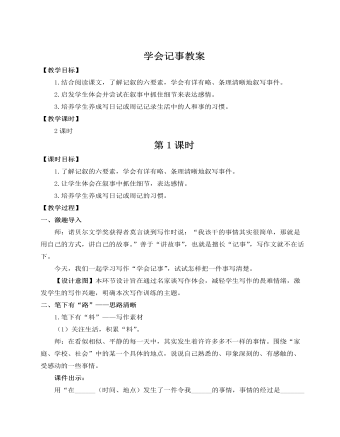
人教部编版七年级语文上册学会记事教案
家是圆心,我们都是圆内的点,爸爸、妈妈和我,我们围着圆心在走,走出一个圆满的家。(开篇点题。)清风摇曳梧桐树的小时候——(独立成段,设置场景,富有意境。)月亮又悄悄爬上了窗外的梧桐树,我靠在床头,该是听妈妈讲故事的时候了,可是妈妈又晚督班去了。妈妈是一名老师,每天兢兢业业,总有忙不完的事情。每次回家,总是带着匆匆的脚步,充斥着紧张的氛围,有时怀里还抱着几本厚厚的书。“妈妈,你不爱我了吗?为什么不在我身边?”我握住妈妈的手,她的手上还有白色的粉笔灰。“孩子……”妈妈哽住了,转过头去,眼里含着透明的水珠。她摸了摸我的头,指了指窗外的月亮:“月儿圆的时候,妈妈就会回来。”我蹦蹦跳跳跑到窗前,每个夜晚不停地寻找那圆圆的月亮——那是妈妈回来的希望。在梧桐摇曳,月儿圆圆缺缺的岁月里,充满了等待的苦涩、团聚的欢乐。
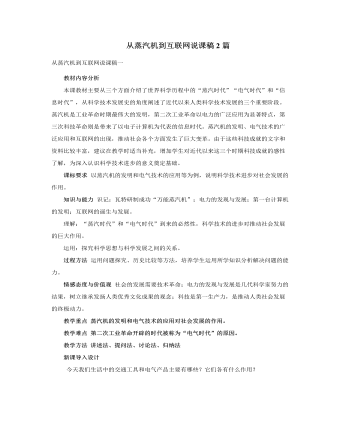
人教版高中历史必修3从蒸汽机到互联网说课稿2篇
2、互联网的功用:(1)功用:提供文件传输、电子信箱、聊天等服务,在社会各个领域发挥了巨大的作用,标志着信息化社会的出现。(2)特点:网络媒体作为一种新的传播媒体,具有界面直观、音色兼备、链接灵活和高速传输的特点。3、互联网的影响:教师提问,学生思考回答,教师总结 (1)信息经济在世界各地全面发展,加快了经济全球化的步伐;(2)传统产业也借助互联网提高管理水平,并通过全球营销和采购扩大市场;(3)在互联网时代,人们可以在家里完成很多工作,提高了工作效率,增加了乐趣;(4)人们的社会交往方式也发生着改变。(5)也带来一些负面影响。【合作探究】3:青少年如何对待网络:互联网在给社会带来巨大效能的同时,也带来了巨大的挑战。青少年应该提高自身的道德素养,树立正确的网络观,让网络发挥出应有的作用。
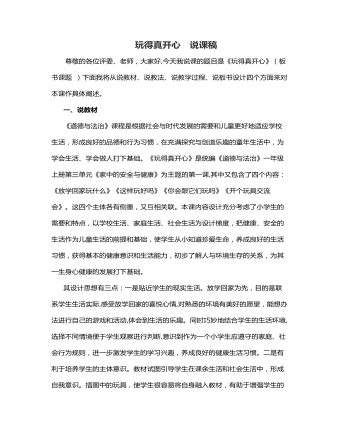
玩得真开心 说课稿
一、说教材《道德与法治》课程是根据社会与时代发展的需要和儿童更好地适应学校生活,形成良好的品德和行为习惯,在充满探究与创造乐趣的童年生活中,为学会生活、学会做人打下基础。《玩得真开心》是统编《道德与法治》一年级上册第三单元《家中的安全与健康》为主题的第一课,其中又包含了四个内容:《放学回家玩什么》《这样玩好吗》《你会跟它们玩吗》《开个玩具交流会》。这四个主体各有侧重,又互相关联。本课内容设计充分考虑了小学生的需要和特点,以学校生活、家庭生活、社会生活为设计梯度,把健康、安全的生活作为儿童生活的前提和基础,使学生从小知道珍爱生命,养成良好的生活习惯,获得基本的健康意识和生活能力,初步了解人与环境生存的关系,为其一生身心健康的发展打下基础。其设计思想有三点:一是贴近学生的现实生活。放学回家为先,目的是联系学生生活实际,感受放学回家的喜悦心情,对熟悉的环境有美好的愿望,能想办法进行自己的游戏和活动,体会到生活的乐趣。同时巧妙地结合学生的生活环境,选择不同情境便于学生观察进行判断,意识到作为一个小学生应遵守的家庭、社会行为规则,进一步激发学生的学习兴趣,养成良好的健康生活习惯。二是有利于培养学生的主体意识。教材试图引导学生在课余生活和社会生活中,形成自我意识。

幼儿园保育工作计划8篇
1、清洁卫生习惯。 养成饭前便后及手脏时洗手的习惯,学会自己卷衣袖,在老师的指导下会用洗手液洗手,不咬指甲,不把玩具放入口中,用毛巾洗脸,保持衣服整洁。 2、良好的进餐习惯。 要安静愉快进餐,坐姿自然,正确使用餐具,左手扶碗,右手拿汤匙,喝汤时两手端碗,养成细嚼慢咽,不挑食、不说话、不浪费、不用手抓菜、不剩饭菜、不弄脏衣服,餐后要喝水、漱口和洗脸。克服幼儿的依赖性,培养幼儿独立性。 3、有良好睡眠及穿脱能力。 能安静就寝,睡姿正确,不蒙头睡觉,学习独立,有序地穿脱衣服,鞋袜,能将脱下的衣裤、鞋袜放在固定的地方,自己叠被子及整理床铺,让幼儿养成良好的习惯。





















